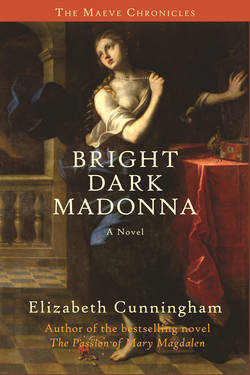Читать книгу Bright Dark Madonna - Elizabeth Cunningham - Страница 10
На сайте Литреса книга снята с продажи.
ОглавлениеPROLOGUE: MY FEAST DAY
How to Become a Saint
IT IS JULY 22ND or, as they say in La Belle France, le 22 juillet. I am not going to tell you which year it is. It doesn’t matter. Time is not something I notice much these days, historical time, that is. But a feast day is different; it is one of those crossroads where chronological time and mythic time meet.
Also, it is hard not to sit up and pay attention when someone is parading your blackened skull in the streets.
Yes, that is what my devotees are doing, as we speak, in the village of Saint Maximin-La Sainte Baume. Though I apparently have fingernails, hair clippings, and bones scattered all over Southern France, and numerous churches have fought over which one houses my true remains, my (alleged) skull is enthroned in the Basilica of Saint Maximin. (Why a church dedicated to me is named for him, I have never understood.)
My skull is the main attraction in Saint Maximin’s over-crowded crypt. The bodies of three other saints (Marcelle, Suzanne, Sidoine, but this is not their story) rest discreetly in their sarcophagi, but my skull is on display, staring at you from behind protective glass as you enter. It is a real skull, and I am pleased to say that it is black, given my association with the Black Madonna who is worshipped all over Europe. And I’ve always loved that line from the Song of Songs: my love is black but comely. (In life, I was a redhead with the problem complexion that goes with that coloring.) The skull is encased in something that looks like a battle helmet with wavy locks flowing out over my shoulders—all gold of course. A brooch engraved with the image of haloed Jesus fastens my gold cloak. I also have wings, by the way, just like the goddess Isis—no accident, whether or not the artist intended it, for I was her priestess for many years. Below where my heart would be is a sealed glass cylindrical reliquary that displays a shred of tissue from my breast bone where he is supposed to have touched me when he said, “Noli me tangere” in the garden of the Resurrection.
I have my own memory of that morning:
I saw him clearly: standing naked under the tree, laughing, beautiful. His wounds still showed, and yet at the same time they were healed.
“Jesus!”
I wanted to rush straight into his arms, but something held me back.
“I know,” he acknowledged. “This body takes some getting used to. It’s the same as when a butterfly is first unfolding its wings. You can’t touch it yet. But cariad, you can come and stand with me, stand with me beneath the tree.”
I walked across the garden to the tree, my feet bare on the damp, sweet earth. I saw that, like him, I was also naked, naked and as radiant as the morning rising all around us. And so we stood together under the tree, not touching but taking each other in more deeply than we ever had before, taking in the whole singing radiance of the world, and giving it back to each other, giving it back to the world.
I have already told the story of how we found, fought and loved each other through death and beyond. I am telling another story now, the story of how I become a saint. I’m telling it, because I don’t quite know how it happened, and I am curious to find out. I mean, for goddess’ sake, people are venerating the bone of my breast, that cave that sheltered my heart—like the cave in the mountains of La Sainte Baume that sheltered me for a blissful time until my daughter dragged me back into the bloody world.
Today, on my feast day, people are celebrating me in that cave, too, La Grotte de Marie Madeleine, a smaller gathering for those pilgrims hardy enough to make the climb up that steep mountain to the cliffs I once shared with the rock doves. They’re saying mass, murmuring prayers, lighting candles, making vows to put up plaques if I will grant them favors, safe journeys, healthy births. They’ve made the place into a church with pews and altars and stained glass windows. For all that, it’s still a cave, my cave, warm in the winter, cool in the summer. And you can still hear the sound of water dripping on stone, as eternal as anything in time.
So how do I feel about being a saint? Does it go to my head? Am I flattered? Wearied? Amused? Well, yes, and appalled, too. Terrible things have been done in my name, though nothing compared to what has been done in his. Still, there is something to be said for being a saint. Saints are what people have since the church took away their goddesses and gods. But in some ways, I have to admit, saints are more appealing than deities. Saints are homely, quirky, incarnate. They have fingernails, bones, and hair. You can touch them. You can talk to them. They might even talk back.
And if a saint also happens to be a Celt, like me, just try to stop them talking.
My name is Maeve. (It rhymes with cave.) You are welcome to call me what you like. Believe me, in my time (and timelessness) I’ve been called a lot of names. If you want to hear a saint talk, sit back, get comfortable. While my skull is being taken from its crypt for its yearly airing under the sun in Leo, while the rock doves still nest in the cliffs by my cave, I will tell you the story of how I became a saint—as much as I know.
